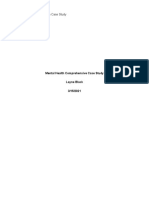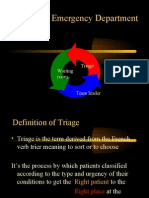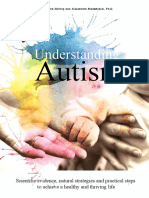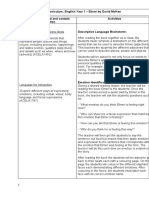Group Assignment Handout
Uploaded by
api-357680810Group Assignment Handout
Uploaded by
api-357680810Autism Spectrum Disorder
What is Autism Spectrum Disorder?
Autism spectrum disorders are a group of complex
neurobiological conditions that typically have an effect on
the person for their whole life.
A diagnosis is based on behaviour and it can be picked
up as early as 18 months old.
Autism usually effects and is noticed in difficulties with
communication, social abilities and interactions, and also
by repetitive behaviours and a low interest in activities.
What causes Autism?
There is no set cause for what triggers the brain
to develop differently in children with autism.
Researches have started to begin to look after
the possible of there being multiple causes,
after realising there are many different types of
Autism.
A strong genetic link is the most accurate
research, however genetics alone can’t account
for all cases.
Effects of Communication and Social Abilities in
people with ASD:
Communication: ASD exists on a continuum,
therefore communication difficulties can span from a
low level of speech to virtually unresponsive to social
contact.
Social Abilities: Students with mild autistic
tendencies may be overly dependent on routines and
be highly sensitive to environmental changes. High-
functioning students with ASD may still experience
social difficulties (i.e. recognising social cues, own
feelings, and other’s feelings, dealing with their own
problems and avoiding conflicts.)
Classroom Strategies:
-Children with ASD often prefer to use their senses as a means for interacting with objects. In
this case it is important to implement sensory learning experiences for the child.
-Teacher should acquire knowledge about the interests of the child with ASD and implement into
the learning.
-The teacher should implement an Individual Education Plan (IEP).
-Setting up routines and creating social stories are a great way of creating order in the child’s
school life. For example, social stories on assembly items, taking turns and sharing, how to
stand in a line, the routine of the school day.
-Visual cue cards can help the child with ASD communicate their needs clearly and are easily
understood by the teacher as well.
-Use of children’s literature in the classroom to explore what ASD is. Some examples of great
texts are Why Is He Doing That? by Racheal Cuellar; My Brother Charlie by Holly Robinson
Peete; My Friend With Autism by Beverly Bishop and Leah’s Voice by Lori Demonia.
References:
Applied Behaviour Analysis. (2019). 30 best children’s books about the autism spectrum.
Retrieved from https://www.appliedbehavioranalysisprograms.com/30-best-childrens-
books-about-the-autism-spectrum/
Campisi, L., Imran, N., Nazeer, A., Skokauskas, N., & Azeem, M. W. (2018). Autism
spectrum disorder. British Medical Bulletin, 127(1), 91-100. doi:10.1093/bmb/ldy026
Larkey, S. (2019). Individual education plans. Retrieved from
https://suelarkey.com.au/individual-education-plans-blog/
Sparks, B. F., Friedman, S. D., Shaw, D. W., Aylward, E. H., Echelard, D., Artru, A. A., ...
& Dager, S. R. (2002). Brain structural abnormalities in young children with autism
spectrum disorder. Neurology, 59(2), 184-192.
Westwood, P. (2015). Commonsense methods for children with special educational
needs (7th ed.). London: Routledge Falmer.
You might also like
- Decoding Love: Navigating Dating and Relationships on the Autism SpectrumFrom EverandDecoding Love: Navigating Dating and Relationships on the Autism SpectrumNo ratings yet
- Unlocking Brilliance: Navigating Autism and Applied Behavior Analysis Towards a Radiant FutureFrom EverandUnlocking Brilliance: Navigating Autism and Applied Behavior Analysis Towards a Radiant FutureNo ratings yet
- Understanding Autism Spectrum Disorder: A Book That Every Parent and Teacher Should HaveFrom EverandUnderstanding Autism Spectrum Disorder: A Book That Every Parent and Teacher Should HaveNo ratings yet
- Autism Spectrum Disorders-Essay On Chapter 11No ratings yetAutism Spectrum Disorders-Essay On Chapter 115 pages
- Identifying And Supporting Children With Autism: A Guide For MothersFrom EverandIdentifying And Supporting Children With Autism: A Guide For MothersNo ratings yet
- Raising An Autistic Child: Implied, in Regard To The Merchantability, Accuracy, or Acceptability of The InformationNo ratings yetRaising An Autistic Child: Implied, in Regard To The Merchantability, Accuracy, or Acceptability of The Information62 pages
- Navigating the Spectrum: A Parent's Guide to Autism in ChildrenFrom EverandNavigating the Spectrum: A Parent's Guide to Autism in ChildrenNo ratings yet
- Unlocking the Spectrum: A Journey through Applied Behavior Analysis from an Autistic PerspectiveFrom EverandUnlocking the Spectrum: A Journey through Applied Behavior Analysis from an Autistic PerspectiveNo ratings yet
- Social Interaction of Preschool Children With Autism Spectrum Disorders (ASD) - Characteristics and Educational ApproachesNo ratings yetSocial Interaction of Preschool Children With Autism Spectrum Disorders (ASD) - Characteristics and Educational Approaches9 pages
- Unit 3 Learning Characteristics of Students With ASDNo ratings yetUnit 3 Learning Characteristics of Students With ASD22 pages
- Childhood Psychological Disorder Research PaperNo ratings yetChildhood Psychological Disorder Research Paper7 pages
- Autism Spectrum Disorder ASD Symptoms Causes DiagnNo ratings yetAutism Spectrum Disorder ASD Symptoms Causes Diagn9 pages
- Early Intervention of Autism: A Case For Floor Time ApproachNo ratings yetEarly Intervention of Autism: A Case For Floor Time Approach28 pages
- Unit-3 Autism Spectrum Disorder: Nature Needs and InterventionNo ratings yetUnit-3 Autism Spectrum Disorder: Nature Needs and Intervention81 pages
- Overcoming Autism Spectrum Disorder in children: Empowering Young Minds: A Holistic Approach to Navigating Autism Spectrum Disorder in ChildrenFrom EverandOvercoming Autism Spectrum Disorder in children: Empowering Young Minds: A Holistic Approach to Navigating Autism Spectrum Disorder in ChildrenNo ratings yet
- Evaluation of A Social Skills Program Using Art Therapy PDFNo ratings yetEvaluation of A Social Skills Program Using Art Therapy PDF10 pages
- Group Report. Section A: Introduction Statement of The Problem-What Is Autisme?No ratings yetGroup Report. Section A: Introduction Statement of The Problem-What Is Autisme?16 pages
- Mirroring Social Learning and Dance Movement Therapy With ChildhNo ratings yetMirroring Social Learning and Dance Movement Therapy With Childh36 pages
- High-Functioning Autism Spectrum Disorder: Parent's Guide to Creating Routines, Diagnosis, Managing Sensory and Autism Awareness in Kids.From EverandHigh-Functioning Autism Spectrum Disorder: Parent's Guide to Creating Routines, Diagnosis, Managing Sensory and Autism Awareness in Kids.5/5 (1)
- Autism: A Mixed Method Study of Awareness and Extent of Autism in PakistanNo ratings yetAutism: A Mixed Method Study of Awareness and Extent of Autism in Pakistan19 pages
- Navigating Autism Together: Your Complete Guide for Understanding and SupportFrom EverandNavigating Autism Together: Your Complete Guide for Understanding and SupportNo ratings yet
- Childhood Autism Rating Scale, 2nd EditionNo ratings yetChildhood Autism Rating Scale, 2nd Edition25 pages
- Autism Is A Disorder of Neural Development Characterized by Impaired SocialNo ratings yetAutism Is A Disorder of Neural Development Characterized by Impaired Social3 pages
- Two Week Integrated Teaching and Learning Program Assessment 3No ratings yetTwo Week Integrated Teaching and Learning Program Assessment 311 pages
- Oral Language Profile of A Child AssignmentNo ratings yetOral Language Profile of A Child Assignment12 pages
- Culturally Responsive Teaching Reflection AssignmentNo ratings yetCulturally Responsive Teaching Reflection Assignment7 pages
- Lesson Plan: Claudia Rocha EDUC2652 Assignment OneNo ratings yetLesson Plan: Claudia Rocha EDUC2652 Assignment One5 pages
- Final Learning Centre Plan - KindergartenNo ratings yetFinal Learning Centre Plan - Kindergarten6 pages
- Tactile, Olfactory, and Gustatory Hallucinations in Psychotic Disorders: A Descriptive StudyNo ratings yetTactile, Olfactory, and Gustatory Hallucinations in Psychotic Disorders: A Descriptive Study5 pages
- Harrison's Principles of Internal Medicine, Twenty-First Edition (Vol.1 & Vol.2) Joseph Loscalzo - Get the ebook instantly with just one click100% (4)Harrison's Principles of Internal Medicine, Twenty-First Edition (Vol.1 & Vol.2) Joseph Loscalzo - Get the ebook instantly with just one click53 pages
- Bmjopen 2021 January 11 1 Inline Supplementary Material 3No ratings yetBmjopen 2021 January 11 1 Inline Supplementary Material 36 pages
- Karakteristik Klinis Dan Tatalaksana Glaukoma Sudut Terbuka Juvenil Di Pusat Mata Nasional Rumah Sakit Mata Cicendo - Andreas Lukita HalimNo ratings yetKarakteristik Klinis Dan Tatalaksana Glaukoma Sudut Terbuka Juvenil Di Pusat Mata Nasional Rumah Sakit Mata Cicendo - Andreas Lukita Halim12 pages
- Monitoring Chart III To Be Used During The Peak of Leakage and During ShockNo ratings yetMonitoring Chart III To Be Used During The Peak of Leakage and During Shock2 pages
- Eugen Bleuler's Dementia Praecox or TH Group of SchizophreniasNo ratings yetEugen Bleuler's Dementia Praecox or TH Group of Schizophrenias9 pages





















































































































